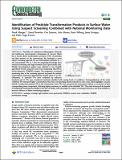Por favor, use este identificador para citar o enlazar a este item:
http://hdl.handle.net/10261/250121COMPARTIR / EXPORTAR:
 SHARE SHARE
 CORE
BASE CORE
BASE
|
|
| Visualizar otros formatos: MARC | Dublin Core | RDF | ORE | MODS | METS | DIDL | DATACITE | |

| Título: | Identification of Pesticide Transformation Products in Surface Water Using Suspect Screening Combined with National Monitoring Data |
Autor: | Menger, Frank; Boström, Gustaf; Jonsson, Ove; Ahrens, Lutz; Wiberg, Karen; Kreuger, Jenny; Gago-Ferrero, Pablo CSIC ORCID | Palabras clave: | Nontarget screening High-resolution mass spectrometry (HRMS) Accurate mass Metabolites TIMFIE Prioritization strategy |
Fecha de publicación: | 22-jul-2021 | Editor: | American Chemical Society | Citación: | Environmental Science and Technology 55 (15): 10343–10353 (2021) | Resumen: | Pesticides are widespread anthropogenic chemicals and well-known environmental contaminants of concern. Much less is known about transformation products (TPs) of pesticides and their presence in the environment. We developed a novel suspect screening approach for not well-explored pesticides (n = 16) and pesticide TPs (n = 242) by integrating knowledge from national monitoring with high-resolution mass spectrometry data. Weekly time-integrated samples were collected in two Swedish agricultural streams using the novel Time-Integrating, MicroFlow, In-line Extraction (TIMFIE) sampler. The integration of national monitoring data in the screening approach increased the number of prioritized compounds approximately twofold (from 23 to 42). Ultimately, 11 pesticide TPs were confirmed by reference standards and 12 TPs were considered tentatively identified with varying levels of confidence. Semiquantification of the newly confirmed TPs indicated higher concentrations than their corresponding parent pesticides in some cases, which highlights concerns related to (unknown) pesticide TPs in the environment. Some TPs were present in the environment without co-occurrence of their corresponding parent compounds, indicating higher persistency or mobility of the identified TPs. This study showcased the benefits of integrating monitoring knowledge in this type of studies, with advantages for suspect screening performance and the possibility to increase relevance of future monitoring programs. | Versión del editor: | https://doi.org/10.1021/acs.est.1c00466 | URI: | http://hdl.handle.net/10261/250121 | DOI: | 10.1021/acs.est.1c00466 |
| Aparece en las colecciones: | (IDAEA) Artículos |
Ficheros en este ítem:
| Fichero | Descripción | Tamaño | Formato | |
|---|---|---|---|---|
| acs.est.1c00466.pdf | Artículo principal | 2,48 MB | Adobe PDF |  Visualizar/Abrir |
| 5523876.zip | Material suplementario | 399,08 kB | Unknown | Visualizar/Abrir |
CORE Recommender
SCOPUSTM
Citations
23
checked on 12-abr-2024
WEB OF SCIENCETM
Citations
20
checked on 21-feb-2024
Page view(s)
57
checked on 18-abr-2024
Download(s)
190
checked on 18-abr-2024
Google ScholarTM
Check
Altmetric
Altmetric
NOTA: Los ítems de Digital.CSIC están protegidos por copyright, con todos los derechos reservados, a menos que se indique lo contrario.
